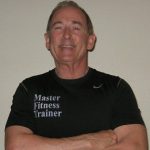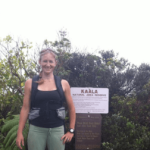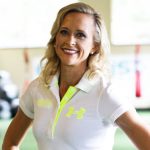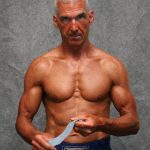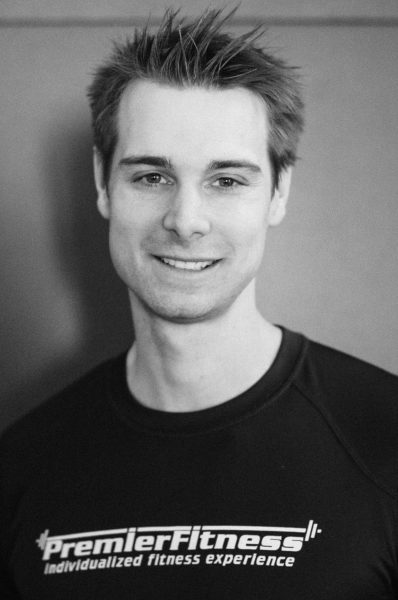
Ian Nimblett is a personal trainer and owner at Premier Fitness in South Salem, NY. Premier Fitness is an 8300 sq ft functional training facility serving over 100 clients. Ian’s first certification was with NFPT in 2009.
Ian was Trainer of the Day for Men’s Health in 2017, he’s an author for the NFPT and has a boatload of wisdom to share about being a gym owner and personal trainer.
Ian covers the pros and cons of running his own gym, family/life balance, who his mentors are, why to put the client first, and much more. Watch the interview and/or read the details now and get pumped!
How did you come to owning your own gym? What’s the story?
I started my career operating as a concierge personal training business. I would train clients at their homes or at their places of work. It was a lot of fun. My day was never the same and I got to meet some of the best people I’ve ever met in my life during this time.
I had this 70-gallon storage tub in my car that was filled with super bands, slam balls, agility ladders and a bunch of other cool stuff. I’d show up, set-up, run the workout and then pack up and leave. I did this on average about 6 – 7 different times a day for about 7 years.
It was a lot fun and it’s the time of my life that I consider to be the most influential in my career. This is where I developed my training philosophies, and honed my skills as a coach. I spent this time investing heavily in studying and taking in as much information as I could. It wasn’t enough for me to just have the piece of paper that said I was a CPT. I knew I needed to be more than that if I was going to be an influencer in peoples lives and for other coaches in the business. So I studied.
I studied the greats in the business and I read as much as could about the way people think and how to motivate people. I tried a lot of things, failed at a lot of things, but learned a ton. One thing I also did during this time was to start setting goals for myself. I set 1-year goals, 5-year goals, and 10-year goals. I would set 3 goals for each time frame.
One was a personal development goal, one was a career goal, and one was a family goal. My first year of goal setting I wrote down that I wanted to open my own studio in 10 years as my career goal. I figured that’s how long it would take because I still had a ton more to learn, I needed to practice and I needed to find the best location I could to be the most influential coach I could be.
In the summer of 2014, an opportunity presented itself and the door for the next step of my journey was opened. I had been running a boot camp (team training) workout at a client’s home for about 16 people and found out from one of my “original members” taking the workout that there was a gym in the area, that had been abandon earlier in the year.
At this point, my daughter was just about to turn 2 and I was feeling like I was missing too much and my wife was ready for me to get off the roads, so to speak. I guess you could say the stars aligned. I took a chance 3 years ahead of my plan and opened Premier Fitness in November of 2014.
How did you choose your space? What factors went into the decision?
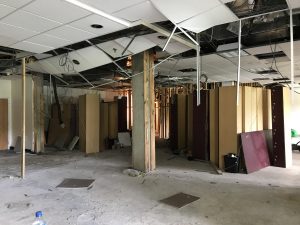
When I thought about the space I needed, it needed to have three things.
1. An open floor plan that could accommodate private training and team training (large group) programs. This meant that I needed at least 3000 square feet, especially since I didn’t want people to feel cramped. (Did you know one of the top reasons people leave gyms is because they feel like they don’t have enough personal space?).
2. Since my training philosophy is function based, which means no machines; we push, pull, squat, lunge, carry, and move, it also needed to have lane space. Said differently longer was better with at least a lane of 40 feet or greater.
3. It needed to have natural light. I think natural light is so important for mental & physical health. Dark spaces are depressing. I wanted people to feel alive and inspired when they were in the studio, not like they wanted to take a nap.
There were also some practical things I kept on my radar as well like parking and location for example. Around here parking can be a challenge and a pain point, so I wanted to avoid that issue if I could. From a location perspective, ideally you want to be in a location where you’ll have street traffic and be visible from the road, but some of the most successful gyms in this country are at the back of industrial parks and are in non-traditional areas. What makes them successful is the product, their coaches, and their experience. People will come if you’re worth it.

We opened up with a little under 3,000 square feet, 2500 of which was training space. I think this was the right amount of square footage to start with. Once we moved out the former gym’s machines, took down a few walls we had plenty of open space.
The building was built in the 70s, so the natural light is amazing. There are skylights and a bunch of different windows with interesting angles. It’s kind of cool.
The space is also more rectangular than square, so the lane space was perfect. Finally, as an added bonus, I got high ceilings (over 20ft high) and a reinforced wall that we use to train for power with ball throws and slams.
Because we’re in a shopping plaza, parking is never an issue and location wise, while we’re not street visible at the back of the plaza, the road we’re on is the main commuting road and is easily accessible for the residents of the town were in, but also for the residents of the surrounding towns. Bonus. Larger market to draw from. More revenue to be had.
If you’re open to sharing about your financial situation when opening your own facility, it might be helpful for others thinking about taking the leap if it’s applicable.
When I set my 10-year goal of opening my own studio, I also defined a bunch of sub-goals I knew I needed to accomplish to get there. One of them was saving as much money as I could. When it was time to open Premier Fitness I think I opened with less than $20,000 of working capital and another $3,000 in fixed assets.
Because I came into a space that was already a gym, I didn’t have a build out to do, and because we’re a functional studio, I knew I could do a lot with a little so the capital I had would work in the short term. I also saved money by doing as much of the finishing work I could myself. I became a better than average painter, hobby I.T. person and expert cleaner.
My wife is also super creative and that came in handy. She hit every flea market, discount store and business liquidation sale she could find to purchase fixtures, lights, storage bins, etc. Since my capital was going to the renovation, operation and start-up costs, I didn’t have much left for advertising. This was scary. I knew I couldn’t generate revenue if I didn’t have people coming through my door. So again I had to get creative.
Social media advertising is cheap and it was a saving grace for me. Even if all I had was a $100 bucks a week, I was able to reach thousands of people through ads and boosting my posts. I also used my previous life skills as an advertising sales rep to forge affiliate partnerships with local businesses. It’s amazing how much business came from good relationships. Finally, I incentivized my members to advertise for me with a quality referral program.
So while in the end, things have turned out ok, I wouldn’t recommend starting a business the way I did. I had a great product because I had invested the time and had it not been for this I wouldn’t have made it. What I lacked was the business know-how and since I wasn’t doing it all myself, I didn’t have time learn.
So I tell everyone this, if you don’t have a business mentor or consultant and you’re thinking about starting your business, no matter the size, you need one. I didn’t have one when I first started and I wasted a ton of money and time as a result. If I had, had the mentors I have now I think things would have been different and I think I could have saved myself a lot of the stress I endured trying to figure it out all by myself. There are a lot of people in this business who are willing to help. So don’t be afraid to ask questions especially if it’s new for you. You will still make mistakes and they will be the greatest learning opportunities for you, but you’ll make far less.
When and how did you decide to expand your gym?
For the first two years, I was the only coach at Premier Fitness. I was working something like 15 hours a day, seven days a week. I certainly wasn’t helping my at home situation, but my wife would bring my daughter to the studio and we made the most of it. We just kept telling ourselves that the short-term sacrifice would be worth it in the end and we just had to make the time we had count.
Finally, when I started feeling like I was telling more clients “no” then “yes” when they requested an appointment time because I simply couldn’t accommodate them, I knew it was time to hire additional coaches. I started with one full-time coach and one part-time coach.
The studio started to get crowded especially when I converted the part-time coach to full-time, so we did things like move equipment around to try and make it work. We also made rules like no PT sessions during team training workouts and no more than 2 PT clients at a time.
All of which was terrible. Not only was I limiting my revenue potential, I was also driving business away. People stop showing up if you can’t take them when they want to workout. The final catalyst was the launch of Small Group Training.
I knew it wasn’t going to be pretty, but I need the service on my menu. I was losing too much revenue, by not having a mid-priced membership option and I had people in team training that really needed to be in Small Group Training. So we launched anyways.
Right away we felt the pain and we pissed a lot of members off. We squished people in and compromised our member experience. It was a circus. Having private, small group, and team training all occurring at the same time was simply not possible and with the increase in demand for more service options (like nutrition), I knew it was time to take over more space to continue to deliver an awesome experience to my members.
The gym that was here before us had something like 10,000 square feet in total. I wanted to maintain the studio feel, so I knew I didn’t want the full remaining 8,000 sq. feet. I decided to take on an additional 5,000 square feet, adding about another 3,500 of actually training space. That would give me approximately 75 sq. feet person at max capacity an hour, Rich Mayo’s magic number for success. The rest was for bathrooms, massage rooms, a break room and some lab space (a place I could put someone on the Inbody scale and have a private conversation).
What do you like the most about having your own facility?
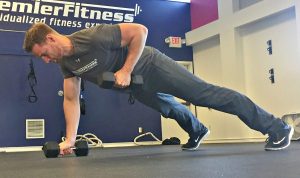
Having something that is mine. Something that I’ve created. Being able to run things on my terms and having people come to me and my team of coaches to change their lives is definitely the most rewarding. 3 years later, I’m as passionate and inspired as I have ever been. I also think a lot about what I’m teaching my daughter through this journey. She’s learning a ton about fitness, about business, about how to treat people and about how to pick yourself up when you fail. Things she’s not going to get in school.
What are the challenges you face running your own facility?
Wow. There are a lot. When I decided to start my own business, people tried to tell me it would be the hardest thing I did. I didn’t get it when they said it, but I get it now. It was hard when I started my concierge business and it was even harder opening a physical location.
If I had to list my top three challenges, they’d probably be as follows;
First and foremost making family time, family time. Sometimes I get so busy with Premier that it is hard to draw the line. There was a point where my wife and I realized that we hadn’t talked about anything other than the business with each other for two weeks straight. That’s when I knew we needed ground rules.
The most important rule is quality, not the quantity. My business is still too immature for me to win the quantity race, so I make it count when I can. I try to stay off my phone and really stay in the moment when I’m in family mode.
The other rule is no business talk after 9 PM and we don’t talk about business before 9 AM. Finally when we can we eat dinner as a family. If we’re all home we do it. No excuses.There’s no TV, no phones, and no work talk.
The second biggest challenge is staffing. Don’t get me wrong I have some great coaches, but no one will ever care about your business like you. Letting go of certain aspects of the day to day is a struggle. In the beginning, I would get so frustrated because a coach wouldn’t queue the way I would have, or they didn’t handle something the way I would have, or they’d make a programming mistake and do the wrong exercise.
It used to infuriate me actually. I had worked to so hard to grow my business and I used to think it was because they didn’t care. Truth is, they do care, probably not as much as me though. I had to learn to look at the situation from the goal level. Did the member have a good experience? Did we keep them safe? Did they leave with a smile on their face? Are we changing their lives? As long as I could answer yes to all these questions, we were good.
These were the questions that mattered the most in that moment. What I do is then address the opportunities for coaching improvements with my coaches during our weekly one-on-one developments meetings and during our weekly team meetings. Which has turned out to be something that is a new and an exciting challenge for me in and of itself. It’s one thing to coach. It’s another to develop a coach.
Finally, for 2+ years, The Premier members had me all to themselves and we were a small boutique that quickly became a family. I had personal relationships with every one of our members and I got to know each and every one of them really well.
When I hired my first coach, it was rough. No one wanted to train with him and everyone was worried the band was breaking up. I had members texting me telling me they felt like Premier wasn’t Premier anymore and they didn’t know if they were going to keep coming.
All I could do was advocate for my coaches, reassure the members that it was still my programming they had come to love and ask them to trust me. My first full-time hire is coming up on their one year anniversary now and it’s him they are bringing breakfast for now, not me.
The first time it happened I won’t lie it hurt a little. It was always nice when a member brought me breakfast or something, but at the same time it was awesome! I knew at that moment Premier was still Premier, even though we had more than tripled in size.
Do you have other trainers working for/with you? If so, are the IC’s or employees? How many?
We have 3 full-time coaches at Premier and are currently looking for two more part-time coaches. We don’t have any independent contractors. I always knew I wanted to only have employees, primarily for control of the product, but also because I wanted to hire people who wanted to be here building the Premier family not building their own brand.
I’m a big loyalty guy. I know people don’t stay for long in this business but when you’re here I expect my staff to be here fully invested in the Premier members and our philosophies. The staff follows my training philosophy and programming, but I have created space for autonomy for them through various protocols I have defined as part of our progression and regression chart. I also have created an intern program, which we accept applicants into three times per year. Our intern program is the feeder pool for my coaching staff and within the next year, I will be at a place where I will only hire from my intern program.
Check out some of Ian’s blogs:
Sled Training Benefits for Better Results
Transform Your Workout with Landmine Exercises
How to Do Rearfoot Elevated Split Squats
[info type=”facebook”]Join the conversation on the NFPT Facebook Community Group.[/info]

